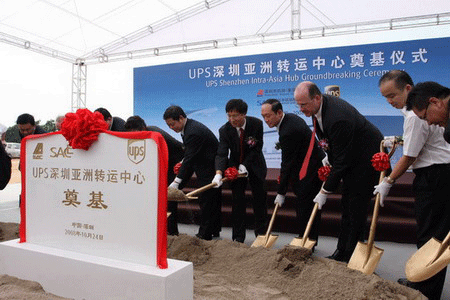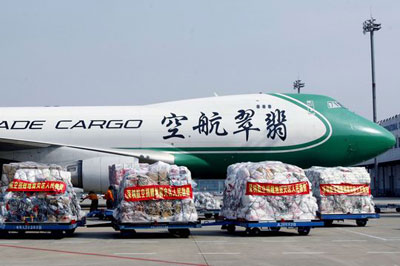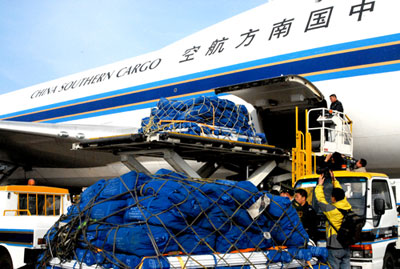UPS Intra-Asia Hub at South
China’s Shenzhen Airport opens tomorrow February 9, and with no
doubt, the airport expects a remarkable growth of its mail and cargo
volume in this new year, especially on international routes.
 During a telephone interview with Mr.
Luo Yi, Board Secretary of Shenzhen Airport Co. Ltd, Air Cargo News
FlyingTypers had a chance to get a full picture of the airport’s
cargo business.
During a telephone interview with Mr.
Luo Yi, Board Secretary of Shenzhen Airport Co. Ltd, Air Cargo News
FlyingTypers had a chance to get a full picture of the airport’s
cargo business.
“Our neighbor airport, Guangzhou
Baiyun Airport has seen big growth brought by the opening of Fedex Asian
Pacific hub at the airport in 2009, and we think this will also happen
in Shenzhen Airport after the UPS hub is put into use this month.”
According to the plan released before,
UPS Intra-Asia Hub will execute no less than 108 all-cargo flights per
week at the airport, but is there any change when this day really comes?
“The actual flight numbers at UPS
hub will be less than what had been precously announced. UPS is moving
a complete cargo network to Shenzhen Airport, and how many flights will
be launched really depends on the Marco-economic environment. Unfortunately
the air cargo business in the world has endured tough times in the past
two years.”
“But I believe the number will reach
the original target step by step, as the economy recovers.”
To the airport, UPS means much more than
increased all-cargo flights landing and taking-off at the airport.
“UPS is a leading player in the
industry, not only its scale of fleet, but also its efficiency. The
operations of UPS at Shenzhen Airport will motivate other cargo carriers
at Shenzhen Airport to improve their efficiency.
“The increased efficiency of these
carriers will bring more cargo business for the airport. And this is
what the airport expects most from the coming of UPS.
“To tell the truth, in economic
terms, the UPS hub itself would not bring much revenue to the airport,
as the carrier will handle everything by itself.
“We also hope the coming of UPS
will help to improve the efficiency of local customs clearing.
“We had planned for a 24-hour customs
clearance operation but were unable to provide enough air cargo goods
to persuade local customs to launch this service. The opening of UPS
hub will make this happen in 2010.”
The economic downturn has not only affected
UPS at Shenzhen Airport, but also Shenzhen-based Jade Cargo International,
a joint-venture all-cargo carrier of Shenzhen Airlines and Lufthansa
Cargo.
Instead of expanding its fleet as originally
planned, the carrier has deployed some of its existing six Boeing 747
freighters out of Shenzhen, to exploit more cargo need at Shanghai and
Tianjin, Mr. Luo told ACN Flying Typers.
The airport is currently launching a great
expansion package with a total investment of RMB8.47 billion (USD1.24
billion), including its third passenger terminal and also a large cargo
zone.
Mr. Luo introduces the layout of the cargo
zone in this expansion plan.
“The expansion project is scheduled
to be completed in August 2012, part of which includes a plan for an
area of 1 million square meters for air cargo development. And in the
long run, let’s say by 2020, a larger cargo zone will be reserved
for carriers based in Shenzhen Airport, with land reclaimed from the
sea. By then, the airport will have a designed capacity of handling
2.4 million tons of cargo a year.”
“However, unlike the passenger terminal
which will be a one-off construction process, warehouses on the cargo
zone will be built step by step to cater to the demand.
“The exact scale of warehouses to
be built in this three-year expansion project still is not clear, but
I expect that new warehouses capable of handling around 400,000 tons
cargo per year is a reasonable estimation.
“Shenzhen
airport currently has an annual capacity of processing 1 million tons
of cargo, while the actual volume handled in 2009 is slightly higher
than 600,000 tons, a number that is 1.2 percent higher than that in
2008.
“There
are now three cargo terminals at Shenzhen Airport, Mr. Luo told ACN
Flying Typers.
“One terminal is for domestic cargo,
which currently is the largest percentage of cargo business at the airport,
with the proportion in 2009 amounting to over two thirds.
 |
 |
“Another
is for China Southern Airlines, which exclusively uses the terminal
to handle its own cargo, consisting of around one sixth of the airport’s
cargo volumes in 2009
“And the third is joint ventured
cargo terminal of Shenzhen Airport and Lufthansa, processing all international
cargo of the airport. But this part experienced a sharp downturn in
2009.”
Another news of note is that Shenzhen
Airport just put into use its first non-local cargo terminal at its
neighbor city Dong Guan on January 21, 2010.
“The Pearl River Delta Region is
now emerging as an integral cargo market, with cargo resources to the
airport that own well-developed cargo flight networks.
“Typically, international cargo
tends to flow from north to south, pooling at Hong Kong Airport; while
domestic cargos flow just in the opposite direction. Shenzhen Airport
geographically is located in the middle of this cargo flow route, so
we must set up ground services to attract more cargo resources to Shenzhen.
“This is much like what we have
done for passengers in other cities, establishing more than ten non-local
passenger terminals in neighbor cities to facilitate and attract passengers
to Shenzhen Airport.”
Looking forward, Mr. Luo said:
“Construction of the expansion project
will not affect the operation of existing terminals and runway at Shenzhen
Airport, but the limited capacity of only one runway has become more
of a bottleneck.
“Since there is no more capacity
to launch more flights during daytime hours, we will encourage airlines
to employ larger jets on some routes, offering more bellyhold capacity
for air cargo.
“Meanwhile, we will continue to
stimulate interest to attract new all-cargo flights, especially on international
routes, which require service only at night. We still have plenty of
capacity to accommodate these services.”
David
|






